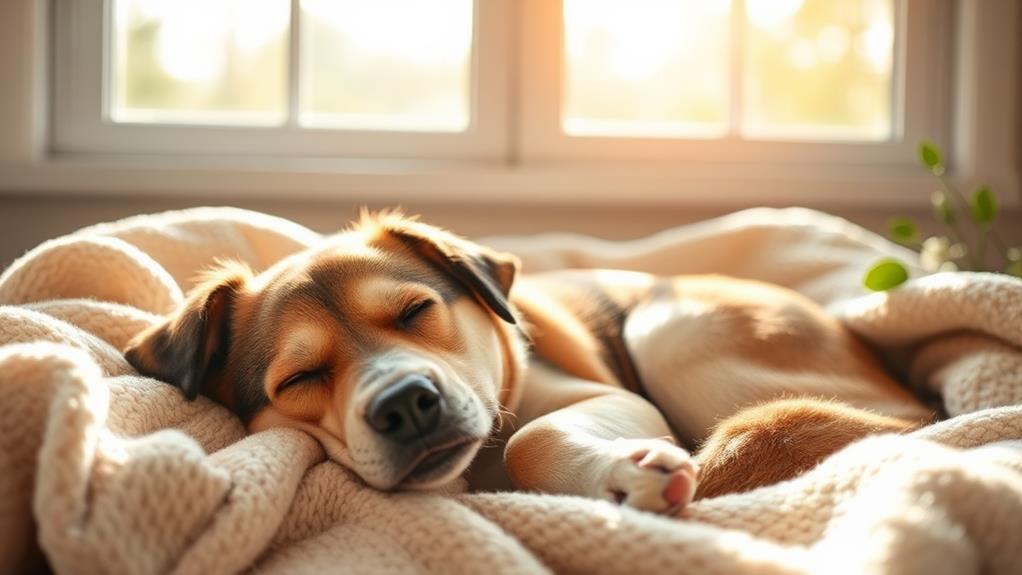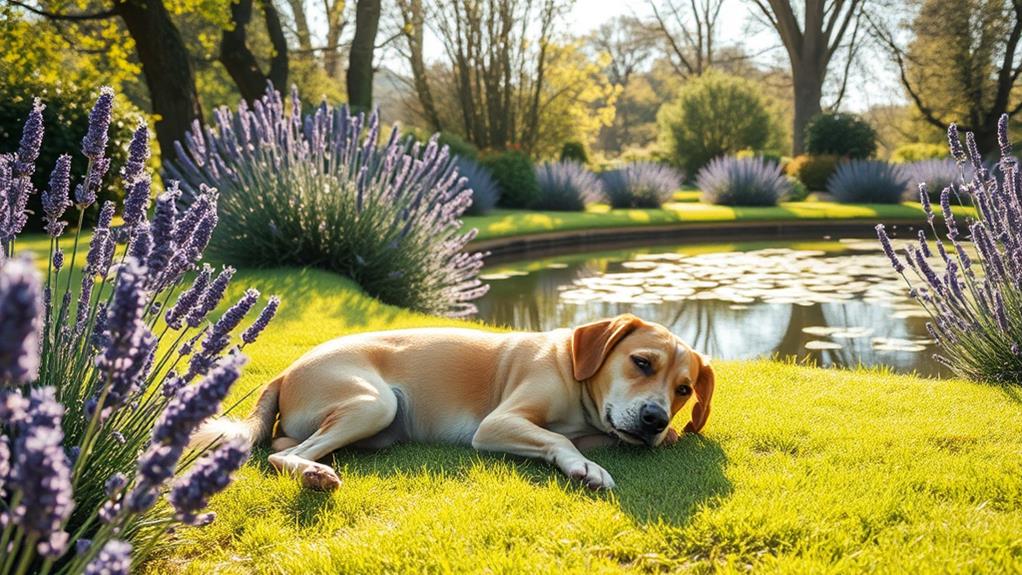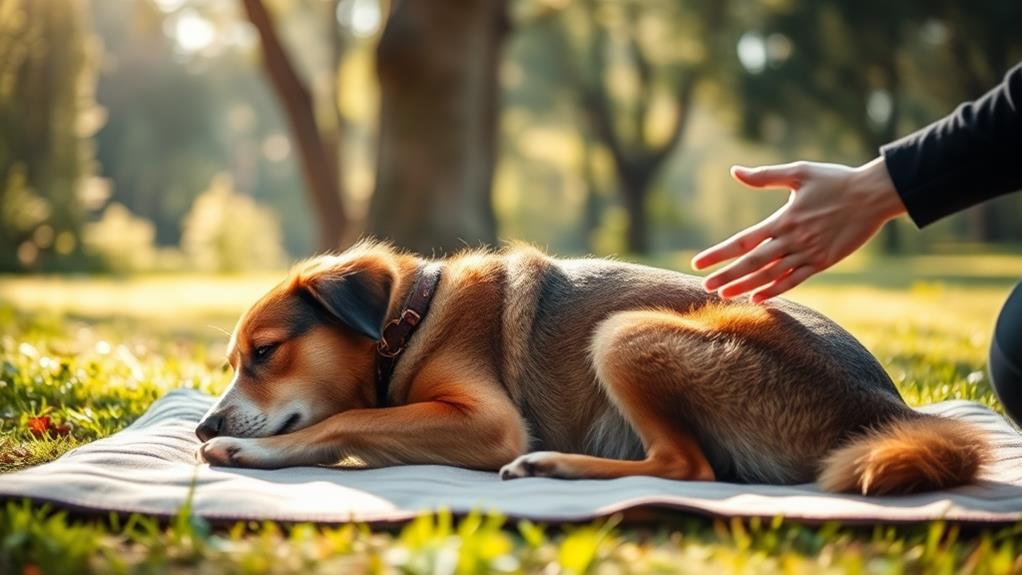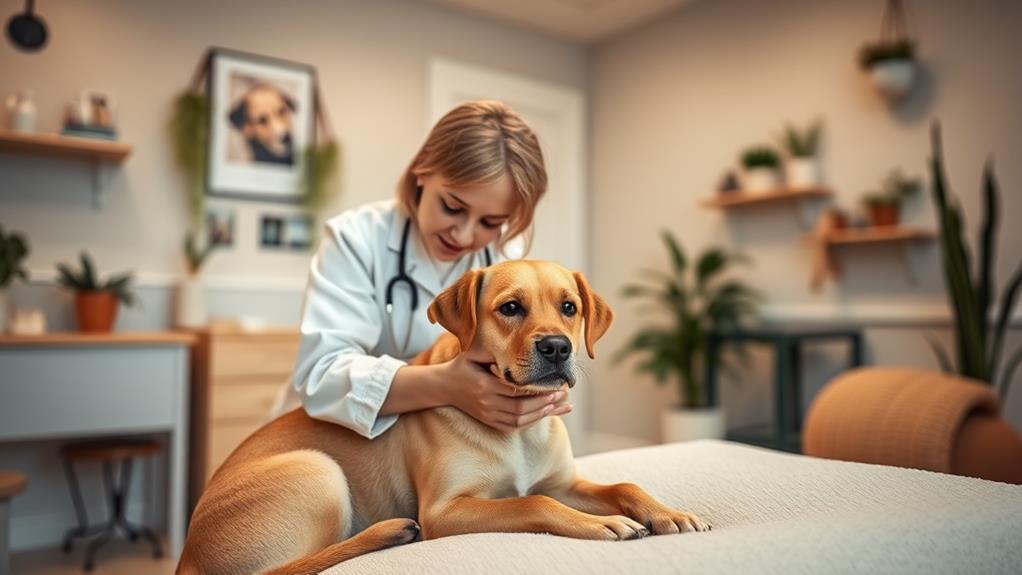Calming techniques soothe anxious dog behavior by restoring a sense of security and reducing stress. When you implement these methods, your dog learns to feel safe, which can lessen symptoms like whining, pacing, or destructive chewing. Techniques such as providing a quiet space, maintaining a routine, or using calming scents can considerably lower anxiety levels. Regularly engaging in physical activity and mental stimulation also helps alleviate tension. As you create a more peaceful environment, your bond with your dog strengthens. You'll find that exploring additional strategies can further enhance your dog's calming practices and overall well-being.
Understanding Dog Anxiety

Understanding your dog's anxiety is crucial for their well-being. Dogs, just like humans, can experience stress and fear, often manifesting in various ways. Knowing what triggers your dog's anxiety helps you address the root cause effectively.
Common triggers include loud noises, separation from you, changes in their environment, or even unfamiliar people and pets.
Your dog's breed can also play a role in their anxiety levels. Some breeds are naturally more prone to anxiety due to their temperament and energy levels. It's indispensable to recognize that anxiety isn't a sign of weakness; it's a genuine emotional response that can be managed with your support.
Signs of Anxious Behavior

Many dog owners frequently notice signs of anxious behavior in their pets, and recognizing these cues is essential for effective intervention. When your dog feels anxious, you might observe various behaviors that can indicate distress. These signs can range from subtle to overt, and being aware of them helps you respond appropriately.
Here's a table highlighting some common signs of anxious behavior in dogs:
| Behavior | Description | Possible Triggers |
|---|---|---|
| Panting | Excessive panting without exercise | Fear, stress, or excitement |
| Whining | Repeated vocalizations | Separation anxiety or discomfort |
| Pacing | Constant movement or circling | Restlessness due to anxiety |
| Tail Tucking | Tail held low or between legs | Fear or submission |
| Destructive Chewing | Chewing furniture or belongings | Boredom or anxiety |
Importance of Calming Techniques

When dealing with an anxious dog, calming techniques play an essential role in restoring their sense of security and well-being. These techniques help reduce stress and anxiety levels, allowing your dog to feel more relaxed and comfortable in their environment. By incorporating calming methods, you can effectively address your dog's fears and phobias, leading to improved behavior over time.
Using calming techniques not only benefits your dog but also enhances your relationship with them. When your dog feels secure, they're more likely to trust you and respond positively to your commands. You'll notice fewer destructive behaviors, reduced barking, and less aggressive tendencies.
Implementing these techniques regularly can create a more peaceful atmosphere in your home. You'll find that your dog becomes more adaptable to changes in their environment, whether it's loud noises, new people, or different situations. This adaptability can lead to a happier and healthier dog overall.
In essence, focusing on calming techniques is vital. They not only help alleviate anxiety but also foster a stronger bond between you and your furry friend, making your lives together more enjoyable and fulfilling.
Natural Remedies for Anxiety

For anxious dogs, natural remedies can provide effective relief alongside calming techniques. You might consider herbal options like chamomile or valerian root, known for their soothing properties. These can help ease your dog's tension and promote relaxation. Always consult your vet before introducing any new supplements, as they can guide you on safe dosages.
Another approach is to use essential oils, such as lavender or cedarwood. Diffusing these oils in your home can create a calming atmosphere for your dog. Just make sure to choose pet-safe oils and avoid direct application on your dog's skin.
You can also explore natural calming chews, often containing a blend of ingredients like L-theanine and hemp. These treats can help reduce anxiety during stressful situations, like thunderstorms or trips to the vet.
Creating a calming environment is vital too. Soft music, a cozy space, and familiar toys can greatly reduce anxiety levels. Likewise, maintaining a consistent routine provides a sense of security for your dog.
Training Techniques for Calmness

Training techniques can markedly help anxious dogs find their calm. Consistency is key, so establish a routine that includes structured training sessions. Use positive reinforcement to reward desired behaviors, like sitting quietly or lying down when they feel anxious. This approach helps them associate calmness with positive experiences.
Incorporate basic commands into your training, such as "sit," "stay," and "down." These commands provide your dog with a sense of structure and control, which can reduce anxiety. Gradually increase the difficulty of distractions during training to help your dog learn to focus despite their anxiety triggers.
Another effective technique is desensitization. Gradually expose your dog to anxiety-inducing situations at a manageable level, rewarding them for staying calm. Slowly increase exposure intensity as your dog becomes more comfortable.
Additionally, consider incorporating relaxation techniques like "mat training," where you teach your dog to go to a designated mat or bed to relax. This creates a safe space for them during stressful moments.
Environmental Modifications

Creating a calm environment is essential for helping anxious dogs feel secure. Start by designating a quiet space in your home where your dog can retreat when they're feeling overwhelmed. This area should be free from loud noises and distractions, allowing your furry friend to relax. Soft bedding, familiar toys, and a few comforting items can make this space inviting.
Next, consider your dog's daily routine. Consistency helps reduce anxiety, so try to keep feeding, walking, and playtimes on a regular schedule. Predictability can create a sense of security for your anxious pet.
You might also want to minimize exposure to stressors. If your dog reacts to loud noises, use rugs or curtains to muffle sound. Additionally, creating barriers, like baby gates, can help limit access to areas that may be overwhelming.
Lastly, consider using calming scents. Essential oils, like lavender, may help soothe your dog when used properly. Just make sure to research pet-safe options and consult with your vet. By making these environmental modifications, you can considerably reduce your dog's anxiety and foster a peaceful home atmosphere.
Physical Activity and Mental Stimulation

Engaging your dog in regular physical activity and mental stimulation is essential for reducing anxiety. When you incorporate exercise into your dog's daily routine, you help them release pent-up energy that can contribute to stress. Take your dog on walks, play fetch, or try agility training—whatever suits their personality. The key is to keep them active and moving.
Mental stimulation is just as important. Dogs need to engage their minds to stay happy and calm. Puzzle toys, interactive games, and scent work can challenge their brain and redirect their focus from anxiety triggers. Teaching new tricks or commands not only builds your bond but also keeps their minds sharp.
Don't forget about socialization! Allowing your dog to interact with other dogs and people can boost their confidence and reduce feelings of isolation. Try visiting dog parks or setting up playdates with trusted friends' pets.
Professional Help and Support

When anxiety overwhelms your dog despite your best efforts, seeking professional help can make a significant difference. Veterinarians and certified dog trainers can provide valuable insights into your dog's behavior and suggest tailored solutions to help manage their anxiety. They can assess your dog's specific needs and recommend appropriate interventions, like training techniques or behavioral therapy.
Consider consulting a veterinary behaviorist if you notice severe anxiety symptoms. They can evaluate your dog's mental health and may prescribe medications to alleviate anxiety. These medications, combined with behavior modification techniques, can create an extensive, detailed, or in-depth approach to your dog's well-being.
Support from professionals can also empower you with the knowledge and tools to assist your dog effectively. Engaging in group classes or workshops led by experts can foster a sense of community, allowing you to connect with other dog owners facing similar challenges.
Building a Routine for Stability

Establishing a consistent routine can greatly benefit your anxious dog by providing a sense of security and predictability. Dogs thrive on structure, and knowing what to expect can considerably reduce their anxiety levels. Start by setting regular feeding times, walk schedules, and play sessions. This helps your dog understand when they'll get their meals and exercise, which can alleviate feelings of uncertainty.
Incorporate calming activities into your routine, like short training sessions or quiet time together. These moments foster a bond between you and your dog, enhancing their emotional stability. Additionally, try to maintain the same departure and arrival times if you leave the house. Consistency in your presence helps your dog feel secure, knowing you'll return.
You should also create a designated space for your dog to retreat to when they feel overwhelmed. This safe haven can be a crate or a specific room where they can relax. Over time, your dog will learn to associate this space with comfort and safety. By committing to a consistent routine, you'll not only help manage your dog's anxiety but also strengthen your relationship, making for a happier, more balanced pup.
Frequently Asked Questions
Can Calming Techniques Be Used for All Dog Breeds?
Yes, calming techniques can be used for all dog breeds. Each dog may respond differently, but with patience and consistency, you'll find effective methods that help soothe your furry friend regardless of their breed.
How Quickly Do Calming Techniques Show Results in Dogs?
You'll often see results from calming techniques almost immediately, yet some dogs may take longer to respond. Patience is key; consistent practice helps your furry friend find their calm and embrace relaxation more effectively.
Are There Any Risks Associated With Calming Techniques?
Yes, there can be risks with calming techniques, like over-reliance on products or methods that might not suit your dog. Always monitor your dog's response and consult a vet if you notice any negative effects.
Can Calming Techniques Replace Professional Veterinary Care?
Calming techniques can help manage anxiety, but they shouldn't replace professional veterinary care. You should always consult your vet for underlying issues and guarantee your dog's needs are met effectively and safely.
How Often Should I Practice Calming Techniques With My Dog?
You wouldn't ignore a stress ball during a tense meeting, right? Similarly, practice calming techniques daily with your dog. Consistency helps build their resilience, making them feel safe and secure in various situations.
Conclusion
In the journey to soothe your anxious dog, remember that patience is key. Like a gentle breeze calming a storm, the right techniques and environment can transform your furry friend's anxiety into tranquility. By integrating calming methods, training, and routine, you'll not only help your dog feel secure but also strengthen your bond. Embrace this process, and watch your pup flourish into a more relaxed and joyful companion. Together, you can turn anxiety into harmony.



